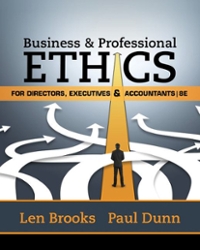By the late 1990s, Nortel Networks Corporation, headquartered in Brampton, Ontario, Canada, was one of the giants
Question:
By the late 1990s, Nortel Networks Corporation, headquartered in Brampton, Ontario, Canada, was one of the giants of the telecommunications industry. Seventy-five percent of North America’s Internet traffic was carried by Nortel equipment,1 which was manufactured by 73,000 employees around the world.2 The company’s shares were listed on both the New York Stock Exchange (NYSE)
and the Toronto Stock Exchange (TSE). By July 2000, the company had issued over 3.8 billion shares worth C\($473.1\) billion in market capitalization at a peak price of C\($124.50\). So dominant was Nortel that it accounted for more than one-third the value of the S &
P/TSE 300 Composite Index.3 Then the infamous dot-com bubble burst, and by September 2002, Nortel stock closed at C\($0.63.4\) John Roth, named Canada’s “business leader of the year” in 2000, indicated that he would step down as CEO in April 2001.5 This may have been partly because he had not foreseen a coming slump in sales and as a result appeared to have misled the investing public. Until Roth’s departure, Nortel was considered to have had an exemplary corporate culture and code of conduct.
Frank Dunn, a CMA who had been head of public affairs and then CFO, was named as replacement CEO in November 2001. He led Nortel through a radical restructuring that saw a reduction in its workforce by 50% to 45,000 in 2001 and a further 10,000 in 2002. Apparently as a result, Nortel’s financial picture showed a profit of U.S.\($54\) million in the first quarter of fiscal 2003, which ended on March 31, 2003. Profits were also reported in the second quarter.
However, on October 23, 2003, when Nortel reported profits in the third quarter, restatements affecting 2000, 2001, and 2002 financial statements were also announced.
Concern over these restatements, delays in financial reports, and concerns over bonuses paid to executives triggered the Audit Committee of Nortel Networks Corporation to authorize an independent review (IR) of the company’s financial affairs by the Washington, D.C., law firm of Wilmer Cutler Pickering Hale and Dorr LLP.
The IR findings resulted in the need for a second restatement of Nortel’s financial statements and the termination for cause of ten senior employees, including the CEO, CFO, and controller. All were asked to repay bonuses received. A further twelve senior employees were required to repay bonuses received and did so. They were not terminated.
The following excerpts provide an overview of the IR and its findings:
In late October 2003, Nortel Networks Corporation (“Nortel” or the “Company”) announced that it intended to restate approximately
\($900M\) of liabilities carried on its previously reported balance sheet as of June 30, 2003, following a comprehensive internal review of these liabilities
(“First Restatement”). The Company stated that the principal effects of the restatement would be a reduction in previously reported net losses for 2000, 2001, and 2002 and an increase in shareholders’ equity and net assets previously reported on its balance sheet. Concurrent with this announcement, the Audit Committees of the Boards of Directors of Nortel Networks Corporation and Nortel Networks Limited (collectively, the
“Audit Committee” and the “Board of Directors” or “Board,” respectively)
initiated an independent review of the facts and circumstances leading to the First Restatement. The Audit Committee wanted to gain a full understanding of the events that caused significant excess liabilities to be maintained on the balance sheet that needed to be restated, and to recommend that the Board of Directors adopt, and direct management to implement, necessary remedial measures to address personnel, controls, compliance, and discipline.
The Audit Committee engaged Wilmer Cutler Pickering Hale and Dorr LLP (“WCPHD”) to advise it in connection with its independent review. Because of the significant accounting issues involved in the inquiry, WCPHD retained Huron Consulting Services LLC (“Huron”) to provide expert accounting assistance.
Huron has been involved in all phases of WCPHD’s work.........
Questions:-
1. Why would Nortel Networks, a Canadian company, hire a U.S. law firm to undertake an independent review of factors that led to restatement of accounting reports?
2. Why did the independent review focus on the “establishment and release of contractual liability and other related provisions” (also called accruals, reserves, or accrued liabilities)?14 3. How did the failure to follow U.S.
GAAP permit the manipulation of Earnings Before Taxes (EBT) and lead to fraudulent behavior?
4. Describe the Nortel Return to Profitability (RTP) and Restricted Stock Units (RSU) bonus plans. What did the board of directors expect these plans to achieve?
5. Were the misstatements of EBT and bonuses paid material in an accounting sense?
6. Why did Nortel’s auditor not discover the misstatements?
7. Why did the Audit Committee (or board as a whole_ not anticipate the manipulation?
8. What questions should the Audit Committee or board have asked?
9. What internal control flaws permitted the fraudulent manipulation to occur without detection?
10. Would the new requirements spawned by SOX and its SEC regulations have prevented the manipulation per se?
Why or why not?
11. How have the expectations of the Audit Committee changed since SOX with regard to corporate culture, why is this so, and how can the Audit Committee ensure that these are met?
12. Should the Audit Committee or the whole board be held legally liable for the weaknesses noted in the review?
Why and why not?
13. In February 2005, Nortel hired a new chief ethics and compliance officer using an incentive compensation scheme based on profits. Is this a sound arrangement?
14. Nortel has issued a new code of conduct with striking similarity to their previous version. Why might this new code be more effective than the last?
15. In retrospect, what were the major failings of the Nortel Audit Committee?
Were they the same as those for the board as a whole?
Step by Step Answer:

Business And Professional Ethics
ISBN: 9781337514460
8th Edition
Authors: Leonard J Brooks, Paul Dunn





